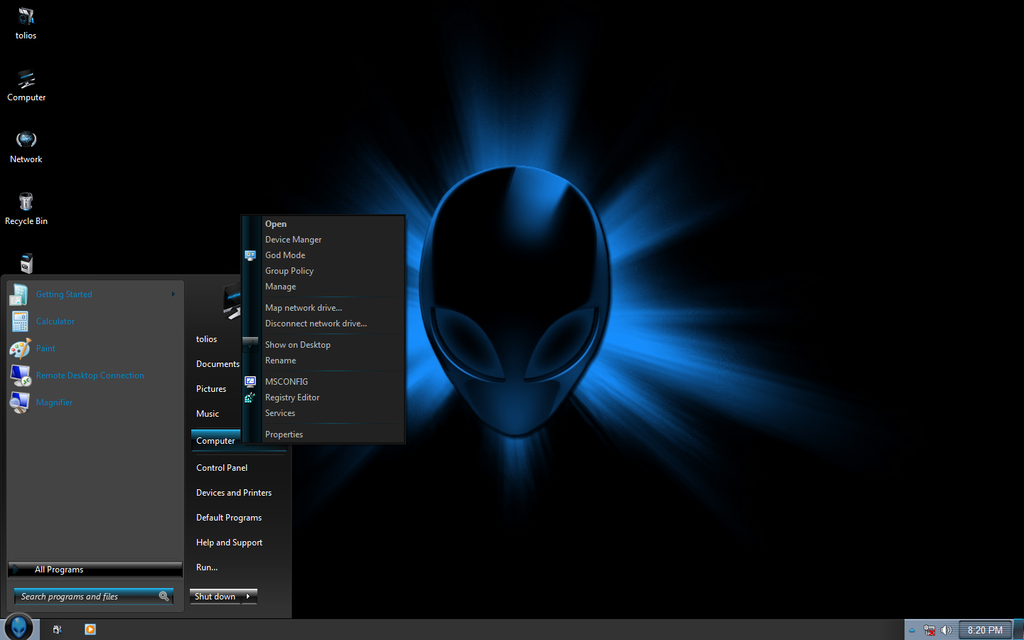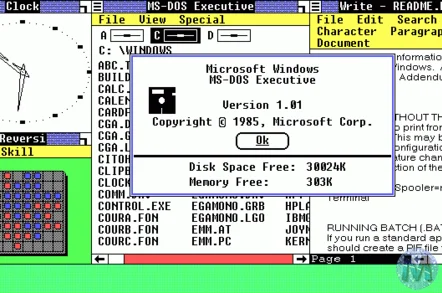Windows 1.0 Iso
Now that Windows 10 20H2 is released, otherwise known as the October 2020 Update, Microsoft has made new ISO disk images for the operating system available.
If you want to perform a clean install of the operating system on a new machine or run into a problem, it is helpful to have a copy of the latest Windows 10 media. In this article we will explain how to download the Windows 10 20H2 ISO directly from Microsoft.
For those not familiar with an ISO image, they are a sector-by-sector copy of a DVD. This ISO file can then be written, or burned, to another DVD to create a replica of the original media, mounted as a drive letter in Windows, or extracted by a program like 7-Zip to access the contained files.

Windows 7 was developed by Microsoft and it was released to manufacturing on and it became generally available on October 22, 2009, less than 3 years after the release of its predecessor, Windows Vista. 1 Download the Windows ISO Downloader tool by HeiDoc.net. 2 Run the downloaded Windows-ISO-Downloader.exe file, and ignore/minimize the advertising window. The Windows-ISO-Downloader.exe file is a standalone.exe file that does not install anything on your computer.
Below we provide a trick that causes Microsoft's site to offer a Windows 10 20H2 ISO rather than the Media Creation Tool.
How to download a Windows 10 20H2 ISO from Microsoft
When you go to Microsoft's 'Download Windows 10' page, you are given the option to update via Windows Update or to download the Windows 10 Media Creation Tool.
Below, we will provide a method that causes Microsoft to offer an ISO image file for Windows 10 20H2 instead.
To download the Windows 10 20H2 ISO, follow these steps:
Windows 1.0 Iso File
- Go to Windows 10 download page in Chrome or the new Microsoft Edge.
- Click on the Chrome menu, then More Tools, and then select Developer tools, as shown below.
- Now press Ctrl + Shift + M to open the Device toolbar. This toolbar lets you force Chrome to impersonate another device such as a mobile phone or a tablet.
Click on the menu that should show Responsive and select iPad or iPad Pro so that you have a larger screen to work with. - When you select one of these devices, you should see the screen resize to reflect the size of the device's screen. At this point, I suggest you change the zoom to 100%, as shown below.
- Now refresh the page in the browser by pressing the F5 key. Once the page refreshes, Microsoft's site will now offer you the Windows 10 ISO instead of the Media Creation Tool.
Now click on the drop-down arrow under 'Select edition' and select the 'Windows 10' option under 'Windows 10 October 2020 Update'. Once selected, click on the Confirm button. - After a few seconds, Microsoft's site will now ask you to select the language for your ISO.Select your language and press the Confirm button again.
- Finally, you will be asked to either download the 32-bit or 64-bit ISO. When ready, click on one of these choices, and the respective Windows 20H2 ISO image will be downloaded.
It should be noted that the above instructions work in any Chromium-based browser, not only Chrome or the new Edge.
How to use the Windows 10 ISO
Now that you have downloaded the ISO, you can use it to upgrade your existing Windows 10 operating system, perform a clean install of Windows 10 20H2 to a new PC, or use it to access the recovery environment for troubleshooting.
For a clean install, you must have a Windows 10 product key available.
Before using the ISO, you will want to make sure you have a spare USB drive that you can use to create bootable Windows 10 USB media.
If you do not have a spare USB drive, you can purchase a 32GB Sandisk drive for about $8.99 or a 5-pack of 64GB USB drives for $30 on Amazon.
You can then create a bootable USB drive from the ISO and use it to install the operating system.
For example, if you can no longer boot your computer due to a virus or wish to enter the Windows 10 Recovery Environment to remove a stubborn infection, you can boot your computer using the Windows 10 installation media to repair the computer.

It is suggested that all users create new media from the Windows 10 ISOs as new feature updates are released.
Related Articles:
Windows 8 has a unique display, appearance and unique features. Microsoft has released it in four editions. But I am discussing here Windows 8/8.1 Pro that’s the most wanted edition of this Windows. Windows 8 Pro missed various important features for professionals. That’s why Microsoft released Windows 8.1 Pro update to cover the missing features.
Related: Windows 8 Core ISO
Download Windows 8/8.1 Pro
Windows 8 Pro x64 ISO
Windows 8 Pro x86 ISO
Download Requirements
Windows 10 Iso To Usb

Windows 10 Iso File 64-bit
- 1GB RAM for 32-bit, 2GB RAM for 64-bit
- 16GB Hard disk space for 32-bit and 20GB for 64-bit
- 1GHz or above processor
Download & Install Windows 8 Pro
Downloading and installation will take place in two parts. In the first phase, I will create Windows 8 Pro bootable USB/DVD and the next phase will explain installation.
Method 1: Create Bootable Windows 8 Pro Via Rufus
Creating a bootable USB flash drive by using Rufus is very easy. It’s for inexperienced users. In this method, you need to follow a few clicks and Rufus will complete the process automatically.
- Click Here to download the tool.
- Now, go to Downloads and click “rufus.exe” to start the installation.
- When the installation is over, launch the tool.
- Now, download Windows 8 Pro ISO from the Download section of this post. (Check your system’s version whether it’s 64-bit or 32-bit. Download the accurate version’s ISO file.)
- Connect a 4GB USB flash drive to your PC.
- In Rufus, click the option “Create a Bootable USB Drive.”
- Now, select “Browse” to open Windows 8 Pro ISO and click “Next.”
- Now, click the option “Start” and “Windows 8 Pro ISO.”
- Rufus will convert the ISO image into an executable file within a couple of minutes.
- That’s it. Your Windows 8.1 Pro bootable USB flash drive is ready.
- Now, plug in USB with PC and restart it to start the installation.
Method # 2: Create Bootable USB via CMD
This method involves some commands. That’s why it seems a bit complicated method. So, I will recommend you to use it if you are an expert in Command Prompt.
Follow the steps below to create a bootable USB flash drive.
- Download Windows 8.1 Pro ISO from the above section and save it to your PC.
- Connect a 4GB USB flash drive with your PC.
- Open the Start menu and look for the Command Prompt.
- Right-click on CMD and select “Run as Administrator” here.
- Here, type a few commands and press Enter every time.
- “list disk”
- “select disc #” (Here, replace “#” with the number where you want to install Windows.)
- “clean”
- “Create partition primary”
- “select partition 1” (You can write here the drive name like C: or D: )
- “active”
- “format fs=NTFS”
- Type “assign letter=X” (You can use any available letter.)
- “exit”
- Type “bootsect /nt60 X:” here.
- Now give the last command to copy the ISO file “xcopy G:*.* X: /E /F /H.” The term “XCOPY” shows a copy of the ISO file.
- That’s all. Now, your Windows 10 bootable USB drive is ready to use.
- Close CMD Administrator.
Installation Guide
- Connect the bootable USB flash drive to the system and restart it.
- When you see the Windows logo, keep pressing F2 and Esc key at the same time to enter BIOS.
- Select “Boot” from here.
- Press the down arrow to move through the list of options and select “USB” here.
- It will show you a few options. Select the relevant option and select “Exit Saving Changes” to exit BIOS.
- Now, click on your preferred language.
- From the same page, select the keyboard input method and Time & Currency format.
- Here, select the “Install Now” option to start the installation.
- Insert the product key.
- Now, click the box “I Accept the Terms” to proceed.
- Here, select the type of installation from “Upgrade” or “Custom.” If you want to keep previous data and files, select “Upgrade.” Select the “Custom: Install Windows only” option if you want to install a fresh copy of Windows.
- Now, make partitions of your Hard disk drive and select the drive where you want to install Windows.
- That’s it. It will show you the installation process in percentage. Wait for a while until it sets up the Windows.
Windows 8/8.1 Pro Features
If you are using Windows 7 Starter, Home Basic or Home Premium, you can upgrade to Windows 8. But you can’t upgrade to Windows 8 Pro. It’s only for users who are using Windows 7 Professional or Ultimate. Windows 8 Pro has very attractive features for users. The basic features for Windows 8 Core and Windows 8 Pro are the same, but there are some additional features too. Let’s have a look at its striking features.
It supports easy gestures. The touch screen and swiping from left to the right and from right to the left display Charms menu.
Semantic Zoom brings more comfort for readers. You can pinch-to-zoom in and out to read the documents or news. You don’t need to scroll down the page.
Since it’s for professional people, it has Microsoft Office complete set of components. You can create documents, sheets, presentations and meeting notes by using MS Office features.
Internet Explorer 10 is even faster and securer. Nobody can steal your personal data or information.
The apps appear in the customizable live tiles with automatic updates. For example, the Mail app shows the number of emails and keeps fetching updates. You don’t need to refresh it again and again to view the latest emails. In the same way, News and Calendar apps bring the latest news and alerts for upcoming events.
Windows Defender protects your system from malicious software. It defends Windows and your documents from viruses, Trojans, malware, and adware.
Enhanced Task Manager brings easier operation for you now.
You can change the language easily due to the Language packs in it.
It provides you with a better multiple monitor support if you are using multiple monitors for a project.
Now access remotely to a desktop and provide assistance to your clients due to the revolutionary Remote Desktop (client) feature. It’s faster and uninterrupted to access files and data remotely.
Lock Screen is a unique addition where you get the latest email alerts, weather, and news alerts without unlocking your PC. It brings meeting alerts, Camera and other features. The Lock Screen is fully customizable.
The apps list has a powerful search feature. You can access an app instantly by typing a few letters in the search bar.
Refresh and reset your PC is very easy now. You can refresh it with one click now. So, when your PC is running slower due to bugs, just tap the refresh button to get a refreshed and faster PC.